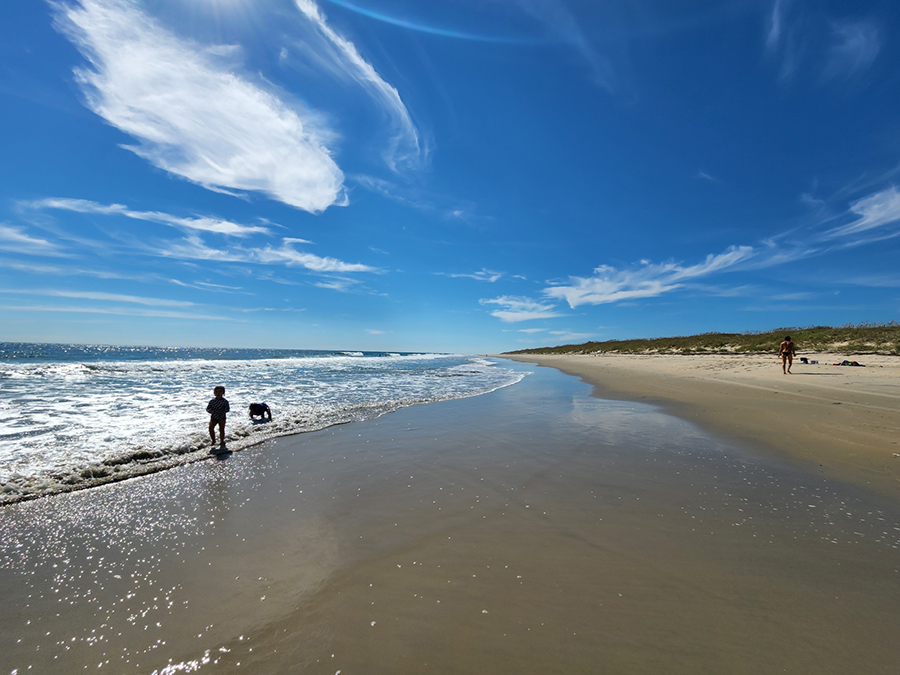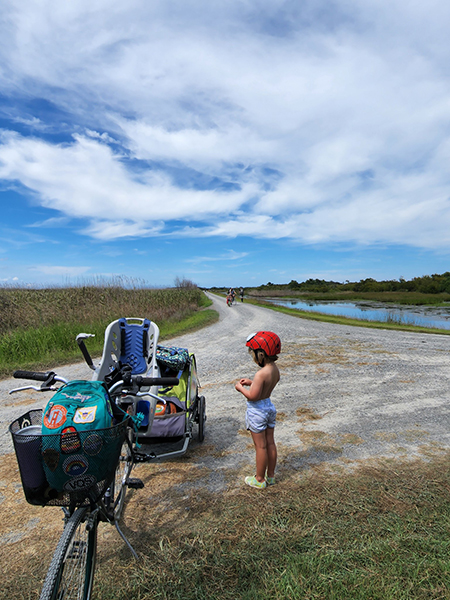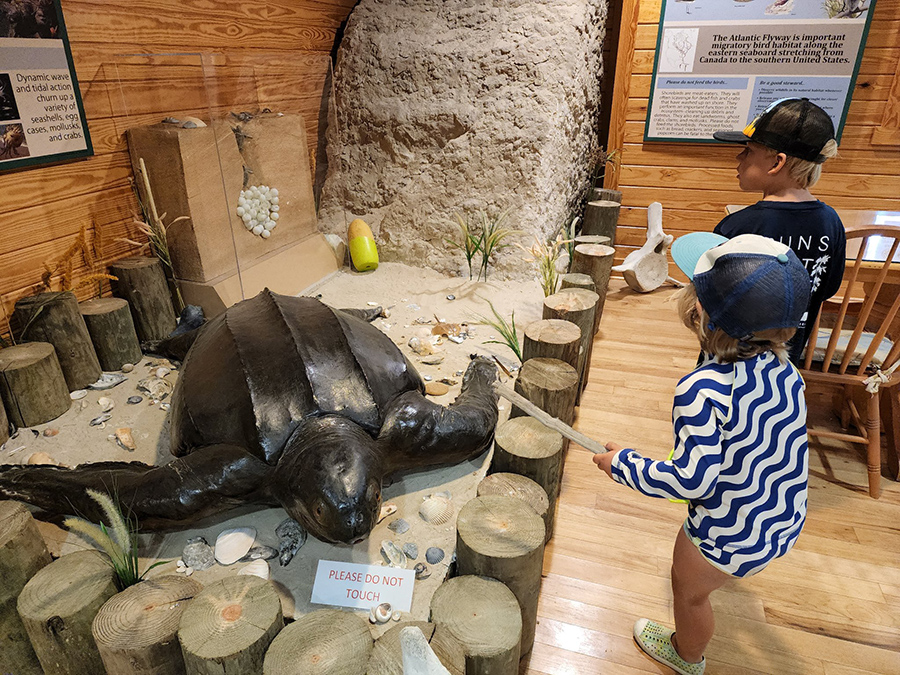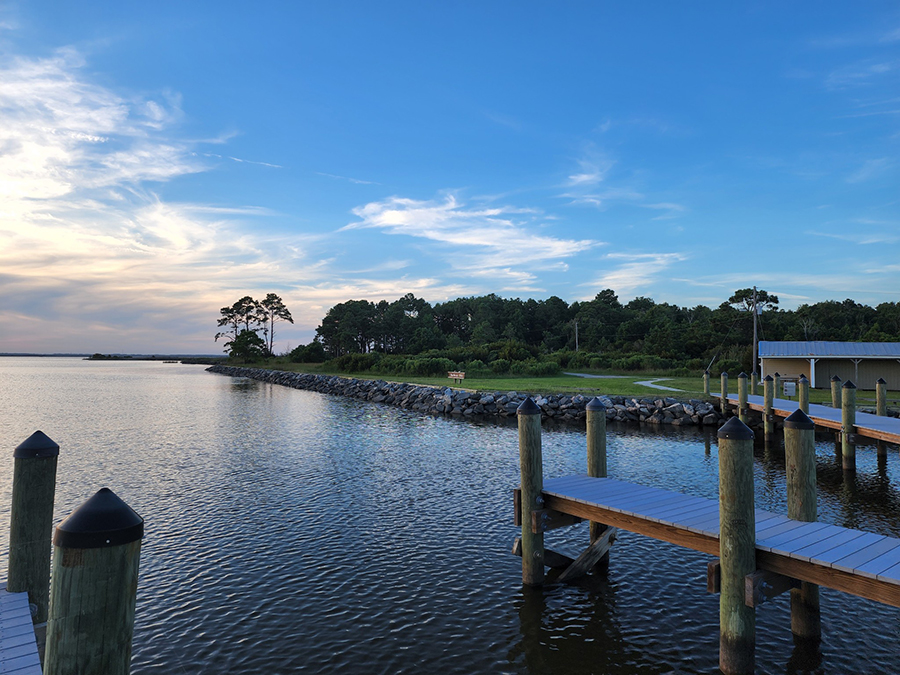The First Adventure
Six miles seemed like a doable distance. After all, the ride would be entirely flat. When I plotted the route to our backcountry campsite, Google Maps assured me that I could walk the entire way in about two hours. Cycling there should be a piece of cake. But, when I planned the three-day family getaway to Virginia’s False Cape State Park, there was one detail I hadn’t fully considered. Half the riders in our group were under the age of six – and their bikepacking skills were still to be determined.
One of Virginia’s most remote protected areas, False Cape State Park spreads over a mile-wide barrier spit nestled between Back Bay and the Atlantic Ocean, just south of Virginia Beach. A patchwork of shifting coastal dunes, marshy wetlands, and forests of live oak and loblolly pine, the slender spit of land has been a state park since 1980, and was designated as one of Virginia’s State Natural Area Preserves in 2002. The park’s southern boundary extends to the North Carolina border, touching the beaches of the Outer Banks. To the north, the protected area is bounded by the Back Bay National Wildlife Refuge (NWR), a 9,200 acre sanctuary for migratory avifauna established in 1938 to preserve the region’s vanishing coastal wetlands. And this means, there’s no motorized access to the park. Instead, to reach the isolated protected area visitors must hike, bike, or paddle through the Back Bay NWR.

For most visitors though, False Cape’s primary appeal is the beach – a six mile stretch of Atlantic coastline frequented by nesting loggerhead sea turtles and migrating harbor seals. And, full disclosure, the beach sold us on the place. Hoping to escape the crowds on Labor Day –and squeeze in one last summer beach trip – my partner Ashley suggested a family cycling trip to False Cape State Park for the holiday weekend. I booked one of the waterside campsites at the Barbour Hill Bay, the closest of the park’s four backcountry camping areas.
We started our ride on Saturday morning, leaving from Little Island City Park, where overnight parking is permitted for visitors to False Cape. By the time we finished loading three-days-worth of gear onto our bikes, both of the kids, four-year-old Eartha and six-year-old Cosmo, were already snacking.
The first leg of our trip involved a mile-long road ride to the entrance of the Back Back NWR, followed by a spin through the refuge on the West Dike Trail. To protect resident birdlife, visitors are only permitted during daylight hours – so we had to finish our ride through the refuge before sunset. And, this meant, we had about seven hours to cover a distance of approximately three miles. But, almost an hour into our expedition, I could still see the silhouette of the refuge’s visitor center on the horizon. The kids had already eaten our most accessible provisions. Every time we stopped, clouds of merciless mosquitos descended on our flesh, and pieces of inadequately-attached gear fell off my bike. I began to worry we wouldn’t be out of the refuge before midnight.

Part of the problem was the gravely trail. While Eartha was being chauffeured in a child’s seat affixed to Ashley’s bike, Cosmo was pedaling a bike with training wheels. And, although he’d ridden endless loops on the tarmac in our neighborhood to prepare for the trip, the rougher terrain was a challenge for him. It was slow going. I’ll readily admit, from a distance, it looked like he was riding a stationary bike.
But, when the kids both seemed close to unleashing monumental meltdowns, we found a patch of shade beside a bayberry bush and regrouped. Cyclists on e-bikes coasted effortlessly past, and secretly, I burned with hostile envy. Through gritted teeth, I chanted serenity now a few times, embracing the timeless self-help mantra from the sitcom Seinfeld. And then, we started pedaling again.
This time though, we devised a strategy for tackling the looming miles. We plotted strategic breaks, picking a fixed point on the horizon, promising sugar-saturated treats awaited, and then cycling there. And miraculously, the tactic worked.
By late afternoon, we rolled into False Cape State Park, the landscape gradually transitioning to a shadowy forest of loblolly pine, and the trail becoming sandier. After less than a mile on the Sandy Point Trail, the silvery water of Back Bay appeared through the trees. Within minutes of reaching our pine-edged campsite, the kids were played tag in the grass – and all signs of crabbiness immediately dissipated. With my backpacking stove, I cooked dinner beneath an iridescent sky streaked with bands of lavender and saffron, watching the sun slide into the bay.
Escaping the Crowds
Sunday morning, we woke to a postcard-perfect beach day. As I steeped coffee in the French press, a belted kingfisher clicked in the scruffy wax myrtle beside the bay and skinks darted across our wooden picnic table. After breakfast, we began the mile-long walk from our campsite to the Atlantic Ocean, our footprints mingling with tracks left by coyotes and white-tailed deer.
About halfway to the beach, the park’s visitor center appeared like a gleaming mirage. Besides the sweet kiss of air conditioning, the facility featured exhibits on park ecology, immaculately clean restrooms, and a small store offering cold drinks, snacks, souvenirs, and camping essentials. As we exited, I made a mental note of the store’s cooler full of ice cream cones, in case I needed a bribe during the afternoon trek back to our campsite.

When we reached the ocean, there was nobody else on the beach. Flocks of sanderlings swept across the shoreline, probing the wave-smoothed sand for prey. Lines of brown pelicans flew in soldierly formation, dipping low over the ocean. And, occasionally, the glistening dorsal fin of a bottlenose dolphin appeared above the forming waves. We’d found something almost unimaginable on Labor Day weekend – solitude.
Not so long ago though, False Cape had a less-that-serene reputation. The slender headland was notorious for shipwrecks, easily mistaken for nearby Cape Henry, a promontory edging the southern entrance to the Chesapeake Bay. In fact, so many vessels stranded that the US Life Saving Service, the precursor to the Coast Guard, established a lifesaving station at False Cape in 1875, one of 285 facilities constructed nationwide. In the late 1800s, a group of shipwreck survivors even banded together to form a settlement on False Cape, constructing buildings from cypress salvaged from stranded schooners. Known as Wash Woods, the community existed until the late 1930s – at one time, populated by more than 300 people. The weathered remains of the settlement still dot the southern portion of the park.
The beach still feels wild. The kids spend the day scouring the sand for treasure, finding the discarded exoskeleton of a prehistoric horseshoe crab, and fistfuls of ‘mermaid purses,’ the leathery pouches shed by incubating skates. After hours in the sun, it’s still hard to leave the ocean.
Beating the Bugs
We were out of the tent before dawn on Monday morning – only to find, a dexterous varmint had unzipped our collapsible trash container overnight, and indulged in a moonlit feast. And, with river otters, raccoons, and non-native nutria in the park, there were plenty of possible culprits.
After cleaning up, we began our six mile ride out just after sunrise, while the grass still glistened with dew and before clouds of insects began hovering along the trail. Like castaways rationing provisions, I doled out the last of the snacks out to the kids – so calories were easily accessible on the trail. And, just to gild the lily, I promised them both their weight in ice cream when we got back to the car. This time, there were no tantrums. In fact, we barely stopped. And, I noticed the small things during the ride – a great blue heron browsing the edge of pond fringed with marsh hibiscus, the sound of a shrieking osprey, and technicolor dragonflies bobbing in the breeze.
Back at Little Island City Park, as I loaded the bikes into the van, and frantically googled ice cream shops that opened before 10 am, I was already thinking about our next trip. Back in the car, I asked Ashley and the kids and it was unanimous – we’re going back this summer. This time, with even more snacks.
Nuts and Bolts
Getting There
For overnight visitors to False Cape State Park, parking is available at the Little Island City Park (just be sure to leave a printout of your camping reservation on the dashboard). From the beginning of November until the end of March, the interior trails at the Back Bay NWR are closed to protect migratory birds – so the only way to reach False Cape State Park is to hike or bike through the refuge along the beach. If you have to travel along the beach, be sure to check a tide chart, and hike or bike during low-tide.

Campground Amenities
The park has four primitive campgrounds – two situated beside the Back Bay and the other two beside the ocean. Drinking water is available for campers at the bayside and oceanside sites at Barbour Hill. There is non-potable water available for campers at the bayside and oceanside sits at False Cape Landing. Drop-toilets accessible from all four campgrounds – and there’s a luxurious indoor bathroom near the Barbour Hill Bay campsites.
While the state park has a 15 mile trail system, some of the interior trails are sandy and challenging to cycle. However, both the East Dike Trail and West Dike Trail through the Back Bay NWR are crushed gravel.
Reservations
Camping is permitted year-round, but reservations are required.

